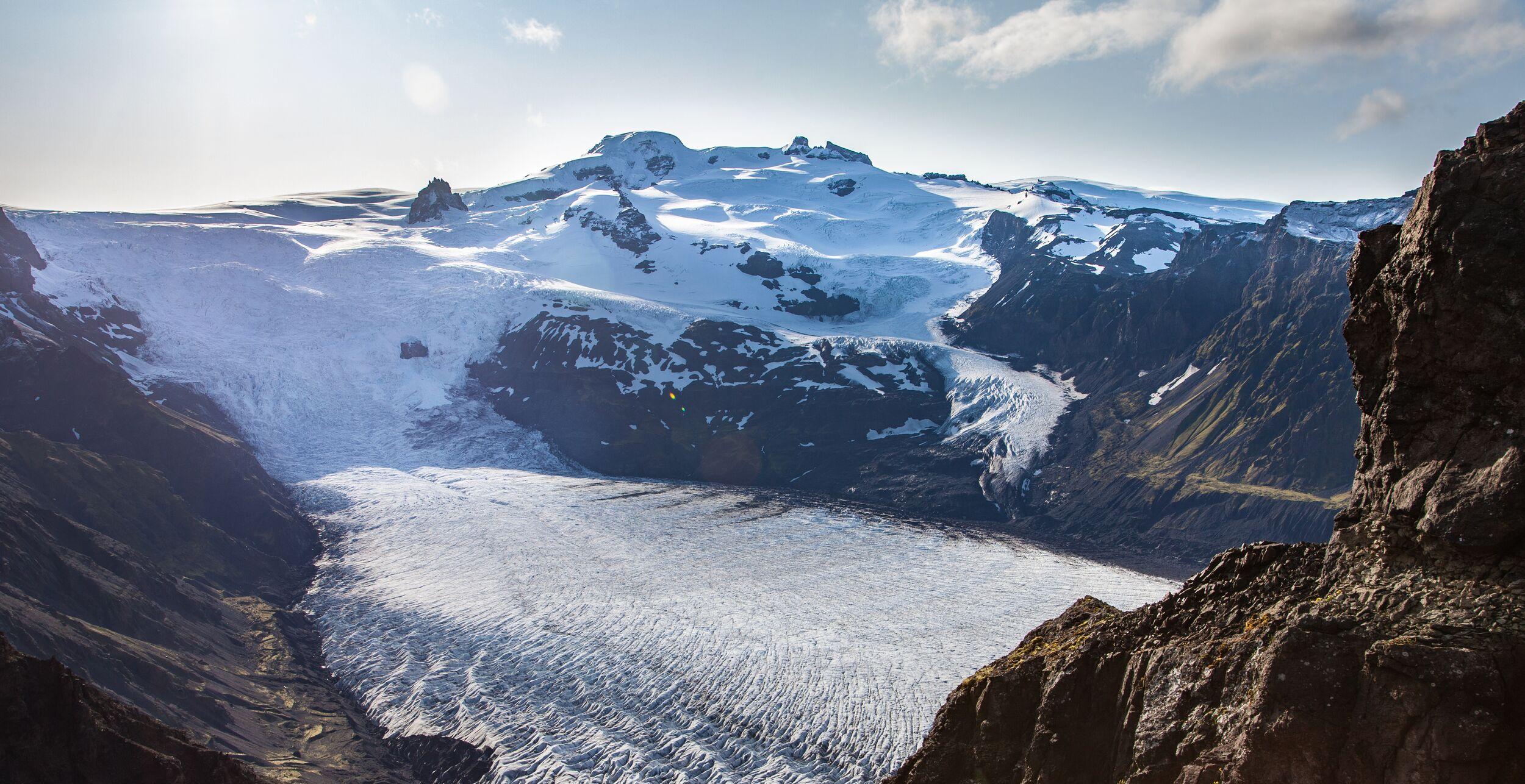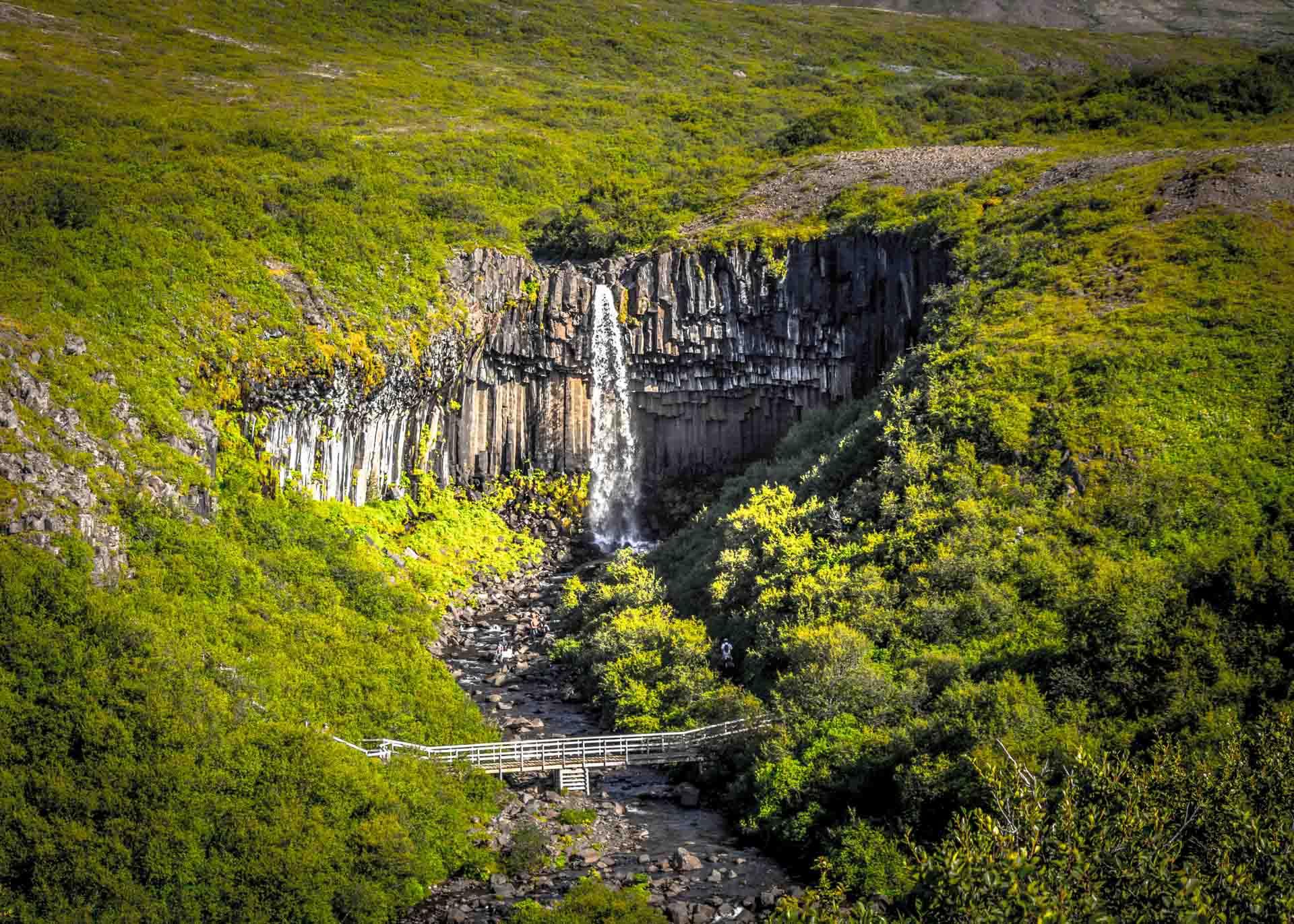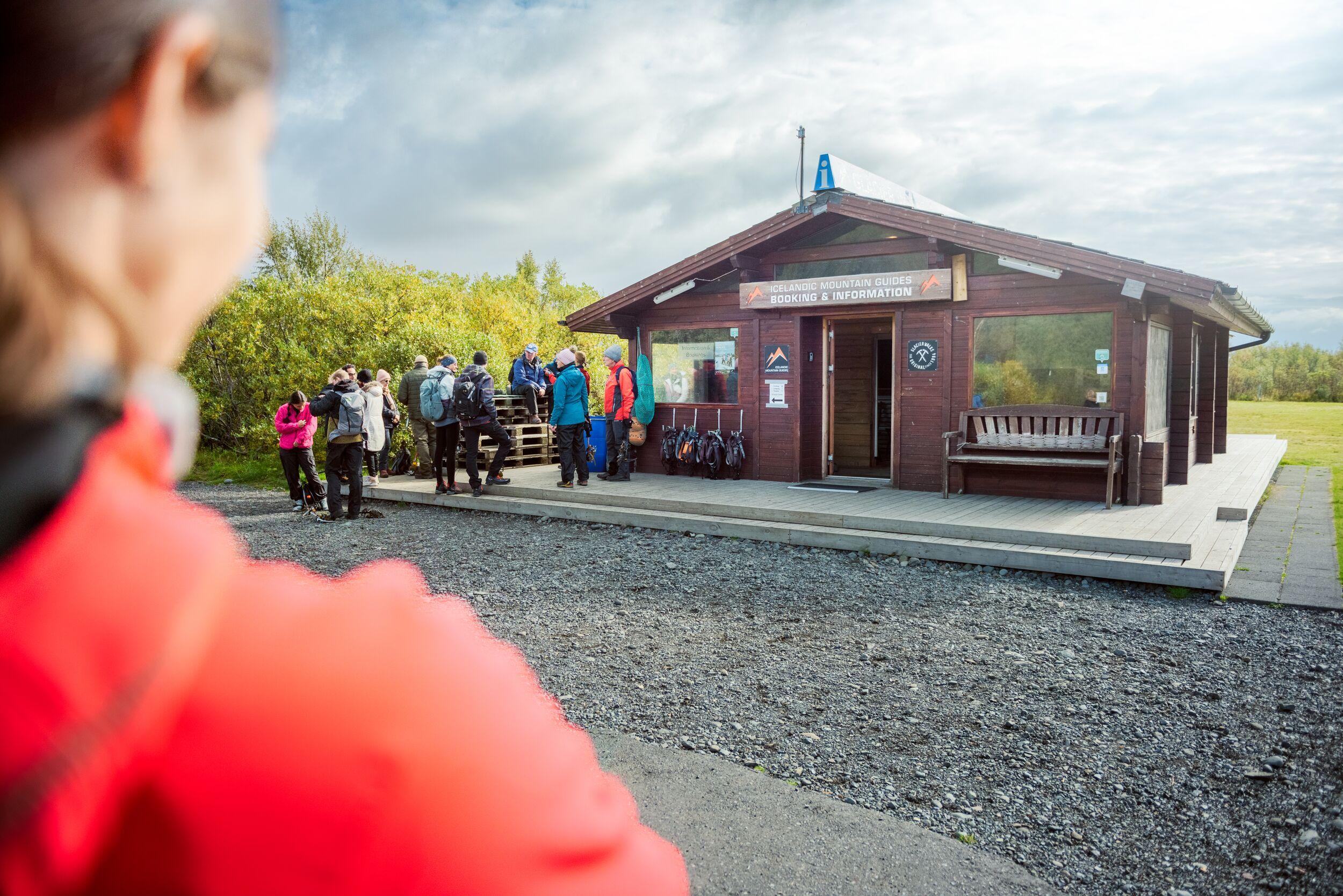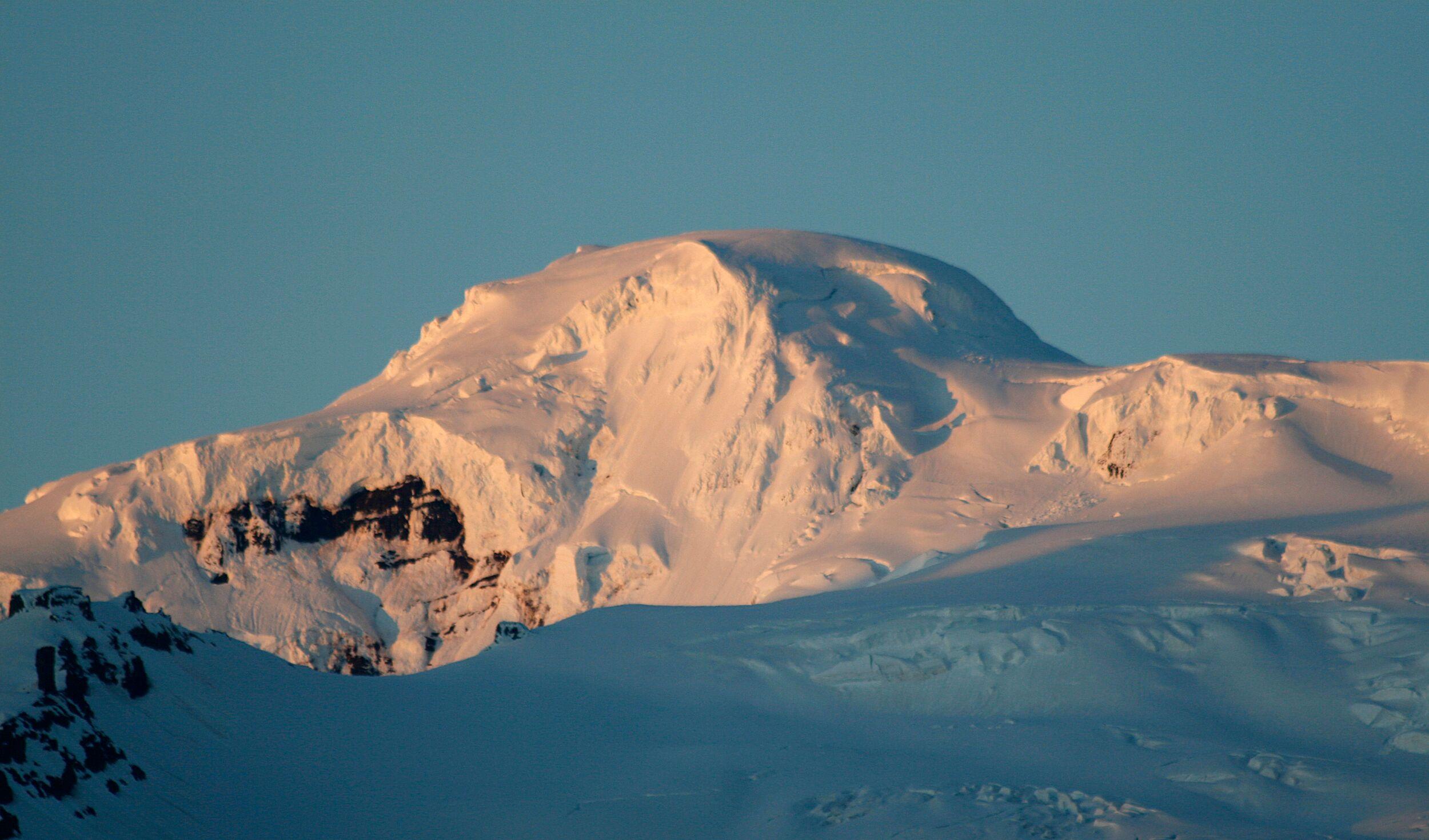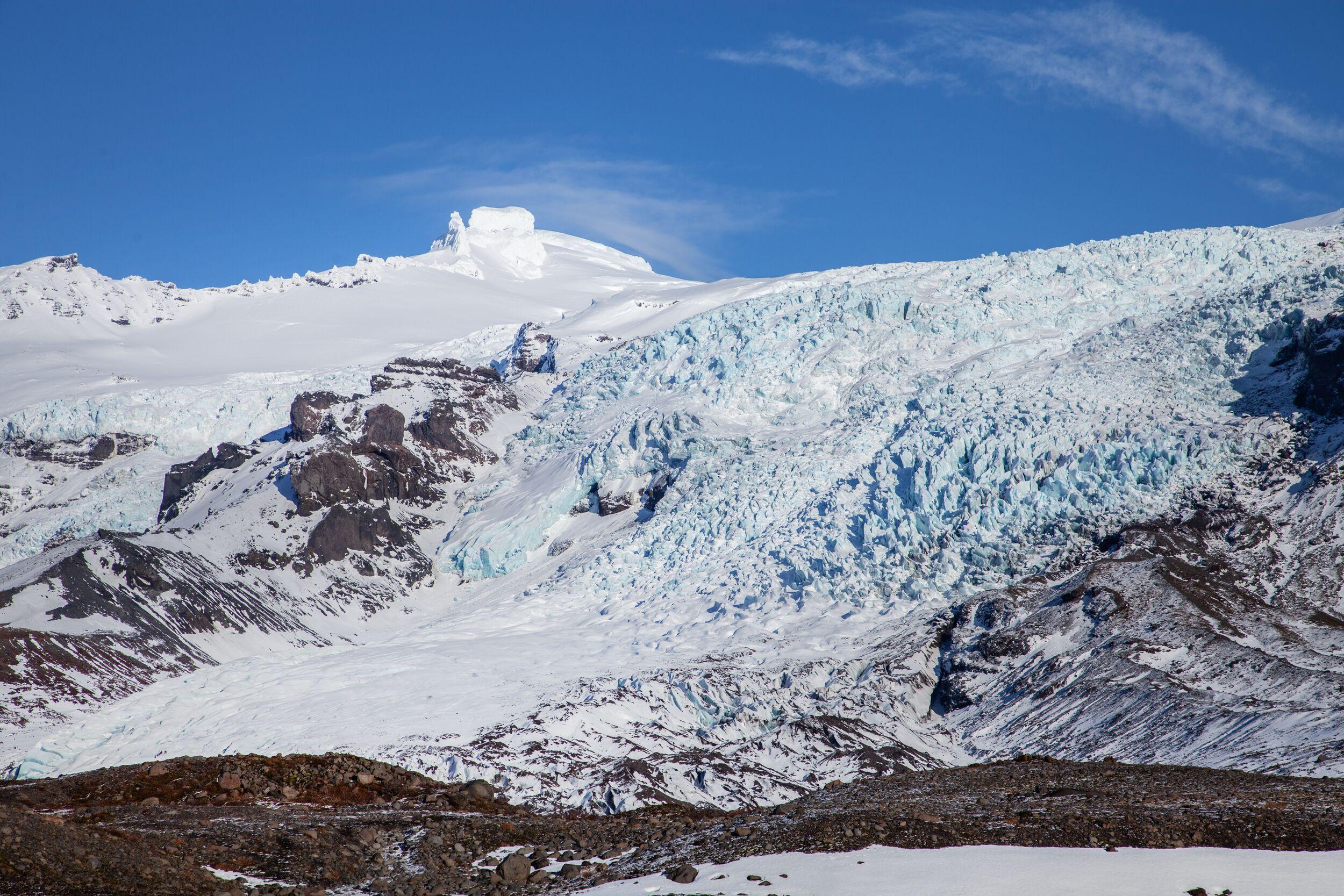
- Best time to visit
- All year round
- Distance from Reykjavík
- 335 km (208 mi)
- Coordinates
- 63.986894, -16.7675750
The Geographical Marvel
Located on the larger Vatnajökull glacier, Falljökull is a prominent outlet glacier that descends dramatically from the main ice cap. Its name, which translates to "Falling Glacier", is apt given its steep decline, appearing as though it’s cascading down from the mountains. This descent provides a visual spectacle, with crevices and ice formations that change seasonally, offering a dynamic panorama for visitors.
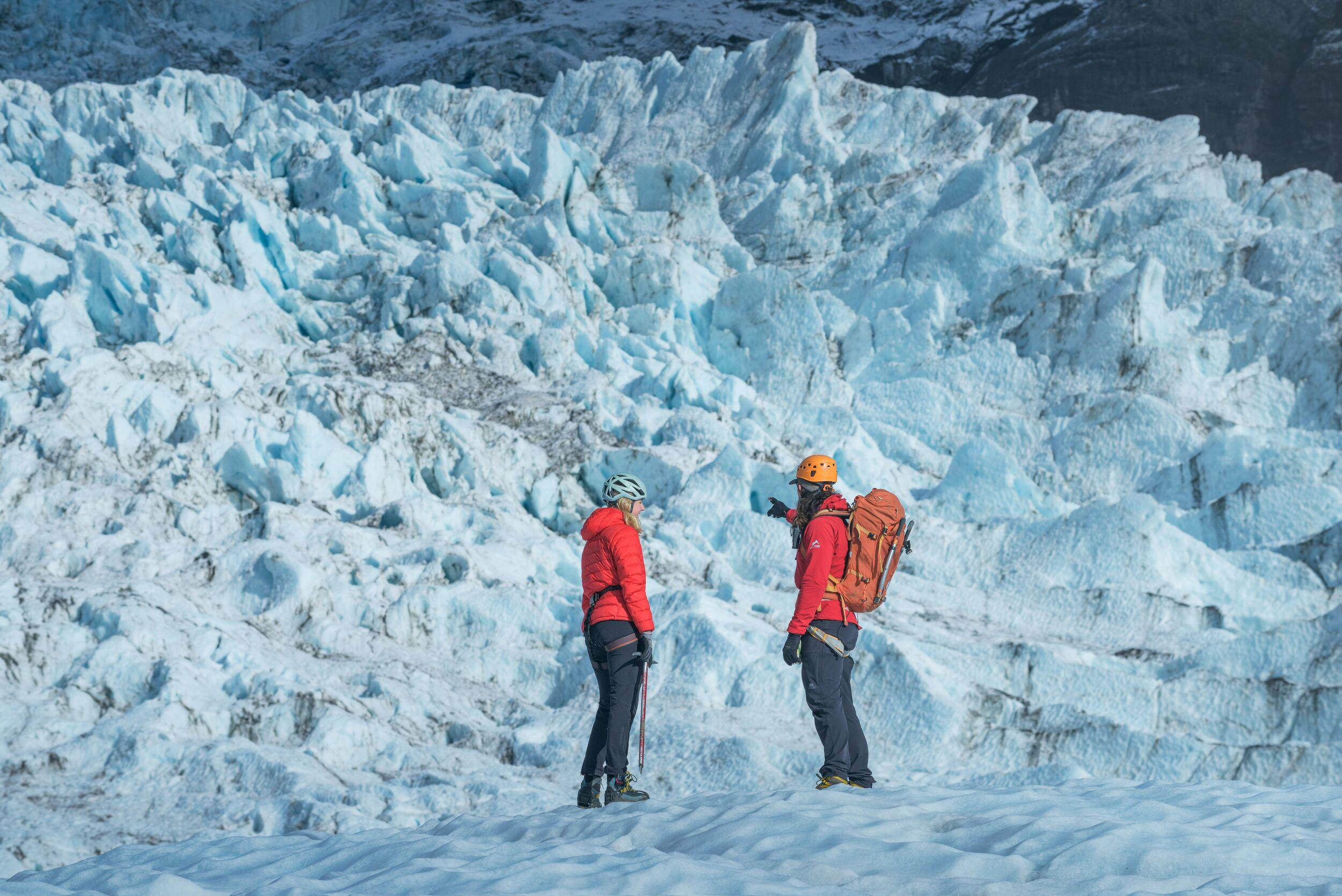
The Premier Destination for Glacier Hiking and Ice Climbing
Often hailed as one of the most thrilling and eye-catching glacier tongues in the country, along with its neighbor, Virkisjökull, it has earned a reputation as a premier destination for glacier hiking and ice caving.
Falljökull offers a wide variety of terrains, making it suitable for both beginners and experienced hikers. Its surface is a mix of smooth ice, rough ridges, and deep crevasses. This ensures that each hike offers a different experience and a new challenge.
The glacier's ever-shifting nature means that ice caves are continually forming and evolving. These caves, with their stunning blue interiors and intricate ice formations, provide a magical experience for those who venture inside.

Safely Explore with Local Guides: Accessible Adventures
Despite its wild appearance, Falljökull is relatively accessible. Guided tours often start from the nearby Skaftafell National Park, making it easier for travelers to explore this icy wonderland.
The backdrop of towering mountains and the expansive Vatnajökull ice cap amplifies the beauty of Falljökull. The panoramic views, especially during sunrise and sunset, are nothing short of ethereal.
Guided tours often provide insights into the formation, movement, and broader implications of glaciers on our planet. This adds an educational dimension to the exhilarating experience.
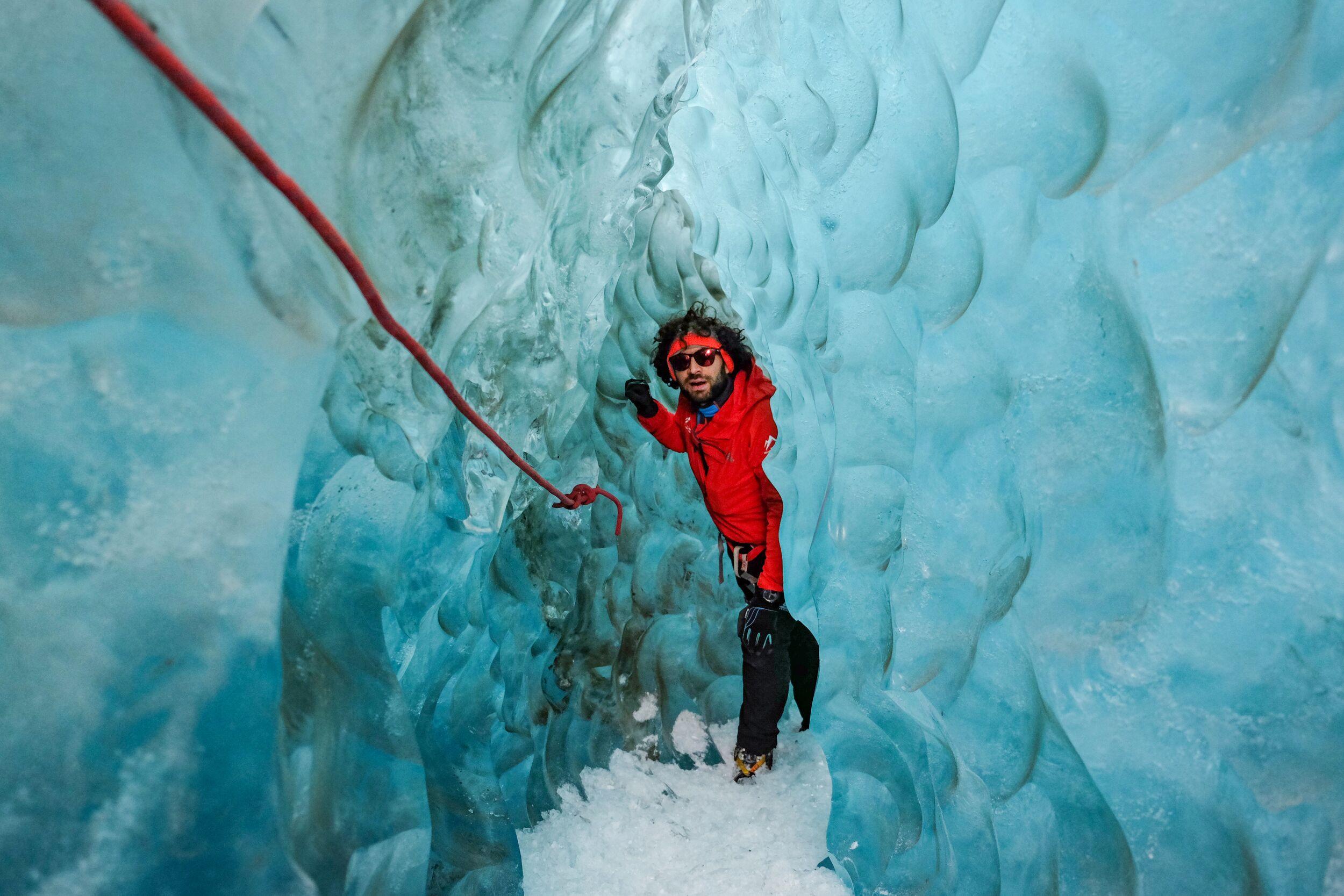
Falljökull holds a mesmerising secret beneath its surface: the beauty of seasonal ice caves. Formed mainly due to summer glacial meltwater that carves channels and cavities, these caves freeze during colder months to offer explorers a glimpse of nature's transitory wonders.
The vivid blue interiors of these caves result from compressed snow turning into ice, which predominantly reflects blue light. Combined with the occasional icicle formations and the distant sounds of the glacier's movement, the ambience within these caves is truly magical.
Safety remains a prime concern when venturing inside. Rapid changes in glacial conditions can render areas unstable, emphasizing the importance of exploring with a seasoned local guide. While these caves are best explored during the colder months, from November to March, consulting local tour operators about cave conditions is always recommended.
The Necessity of Guided Tours on Glaciers
Exploring glaciers, especially intricate features like ice caves is an exhilarating experience that unveils the raw beauty of nature. However, the dynamic and unpredictable nature of glaciers makes them treacherous terrains for the uninformed or unprepared.
It is imperative to join a guided tour when venturing onto glaciers or into ice caves. Professional guides possess comprehensive knowledge of the current conditions, safe routes, and potential hazards. They are trained to respond to emergencies and have equipment designed for glacier safety.
Falljökull Glacier is not just another icy expanse in Iceland; it's a living testament to nature's grandeur and dynamism. Its reputation as one of the most thrilling glacier tongues is well-deserved. Whether you are looking for an adrenaline-pumping hike, a serene ice cave exploration, or simply a moment of awe in nature's embrace, Falljökull awaits with open arms.
All You Need To Know About Glacier Tours
Dressing appropriately is essential for a successful and comfortable glacier hike. Here are some suggestions:
Layer Up: Weather in Iceland can be highly changeable, so wearing layers is key. Start with a moisture-wicking base layer (think thermal underwear), add an insulating middle layer like a fleece or a light down jacket, and finish with a waterproof and windproof outer layer.
Trousers: Opt for waterproof hiking trousers. Jeans are not recommended as they can get cold and uncomfortable when wet.
Footwear: Wear sturdy, waterproof hiking boots that provide good ankle support. Ensure they're comfortable for long periods of walking and are compatible with crampons. Some tour operators might offer rental boots.
Accessories: Don't forget a warm hat, gloves, and sunglasses - the glare off the ice on a sunny day can be intense.
Backpack and Hydration: Bring a small backpack with water and some snacks. Even if the weather is cold, glacier hiking can be strenuous and hydration is important.
Extra Change of Clothes: Finally, it's a good idea to have a change of clothes waiting for you back at your accommodation. After a day on the glacier, you'll appreciate getting into something dry and warm.
Remember, it's always better to over-prepare for the conditions than to find yourself cold, wet, or uncomfortable during your hike. The better prepared you are, the more you'll enjoy this incredible experience.
Sólheimajökull and Skaftafell are two different locations in Iceland, each having its unique characteristics and attractions.
Sólheimajökull is a glacier tongue that extends from the mighty Mýrdalsjökull glacier, Iceland's 4th largest ice cap. It is located on the south coast of Iceland between the volcanoes Katla and Eyjafjallajökull.
The area is renowned for its beauty and is perfect destination for glacier hiking and ice climbing due to its easily accessible location and terrain. We offer a variety of tours at Sólheimajökull, which are especially suited for families and those seeking a more relaxed experience.
Skaftafell is a nature reserve located in the Vatnajökull National Park in the south-east of Iceland. It is a green oasis nestled under the white expanse of Vatnajökull, Europe's largest glacier. Skaftafell is a hiker's paradise, with trails leading to stunning attractions and picturesque glacial tongues.
Skaftafell's glaciers are known for their rugged terrain and fantastic views. The tours we operate here are particularly designed for those with an adventurous spirit. If you're a keen hiker or climber, you'll find the challenging landscapes of Skaftafell incredibly rewarding.
While it may be physically possible to walk on a glacier in Iceland without a guide, it is strongly discouraged due to safety reasons.
Glaciers are complex and potentially dangerous environments, with risks such as hidden crevasses, unstable ice, and rapidly changing weather conditions topped with Iceland's constant earthquakes - often unnoticeable for humans but very much affecting the movement of the glaciers.
Guides for glacier tours are highly trained professionals who understand the glacier's current conditions, know how to navigate safely on the ice, and are equipped to respond to emergencies. They also provide the necessary equipment, such as crampons, ice axes, and safety ropes, which are vital for safe glacier exploration.
In the interest of your own safety and the preservation of these extraordinary but fragile environments, always go with a guide when venturing onto a glacier. The experience and knowledge the guides share will also likely enrich your understanding and appreciation of these amazing landscapes.
The size of Iceland's glaciers varies significantly, with the larger ones being among the most massive in Europe.
- Vatnajökull: The largest glacier in Iceland, and indeed in all of Europe, Vatnajökull stretches over 8,100 square kilometres — about 8% of the country's total land area. It's an ice-covered wonderland, with thickness reaching up to 1,000 metres in some areas.
- Langjökull: The second-largest glacier, Langjökull, covers approximately 953 square kilometres, with its ice up to 580 metres deep.
- Hofsjökull: This is Iceland's third-largest glacier, covering an area of about 925 square kilometres with its ice reaching 600 metres in thickness.
These glaciers and the country's other ice bodies are constantly evolving due to climate factors, so their exact size can change over time.
Absolutely! Glacier hiking is an incredible way to explore the beauty and raw power of Iceland's natural landscape. The unique experience of walking on centuries-old ice, seeing the magnificent ice formations, deep crevasses, and in some cases, brilliantly blue ice caves, is definitely a memory to cherish. The views from the glaciers are also typically spectacular, adding another dimension to the adventure.
The difficulty of a glacier hike in Iceland can vary significantly depending on the specific trek and the weather conditions on the day of your hike.
Some hikes are quite gentle, requiring only a basic level of fitness and agility, while others can be quite strenuous, involving steep climbs and more challenging terrain.
Even on the less demanding hikes, keep in mind that you'll be walking on an uneven, icy surface, often with inclines. The use of crampons and ice axes (which are provided as part of a guided tour) can also take a bit of getting used to.
Before booking a glacier hike, it's a good idea to consider your own physical condition, stamina, and any pre-existing health conditions. If you are in good general health and lead an active lifestyle, you should be well-suited to most glacier hikes. But if you're unsure, check with the tour provider – they will be able to advise you on the best option for your fitness level.
Regardless of the level of difficulty, glacier hikes should always be undertaken with a guide for safety reasons. A guide will be able to ensure you're equipped with the correct gear and that you understand how to use it correctly. They'll also be familiar with the current glacier conditions and can adjust the route or pace as necessary.
If you're based in Reykjavik and looking for a convenient glacier to visit, Sólheimajökull would be a prime choice. It's an outlet glacier of the larger Mýrdalsjökull, and it's about a two-hour drive from the capital.
Sólheimajökull is a favourite among both locals and visitors for its accessibility and beautiful ice formations. It offers a variety of guided tours that range from basic glacier walks to more advanced ice climbing.
Vatnajökull is a great option for those who'd like to immerse themselves in a slightly more challenging experience and are willing to walk further to leave the crowds behind and enjoy the fantastic scenery.
The age of ice in Iceland's glaciers can vary greatly, depending on a number of factors such as the specific glacier, the location of the ice within the glacier, and the rate of ice flow. However, generally speaking, the ice in the deepest parts of the larger glaciers like Vatnajökull can be hundreds to thousands of years old.
Vatnajökull, for instance, has an average ice thickness of about 400 metres and a maximum thickness of around 1,000 metres. Given typical compaction rates and accumulation of snow, the ice at the bottom of this glacier could be over a thousand years old. However, dating glacier ice precisely can be complex due to the dynamic movement and continuous melting and freezing within the glacier.
For smaller glaciers or the younger, upper layers of larger glaciers, the ice may only be a few decades to a few hundred years old.
These are rough estimates and the exact age of the ice can vary. Scientists use various methods such as ice core drilling and radiocarbon dating to determine the age of glacier ice more accurately.
Expect a journey into an ethereal world of ice with unique formations and sometimes stunning blue hues.
A typical glacier hike will start with a safety briefing and gear check. Your guide will then lead you onto the glacier, using crampons for traction. You'll likely walk past — and sometimes over — beautiful ice formations and deep crevasses, and if you're lucky, you might get to explore an ice cave.
Keep in mind that the weather in Iceland can be unpredictable, so conditions might change during your hike, adding to the adventure!
The depth of ice in Iceland's glaciers varies substantially depending on the specific glacier in question.
- Vatnajökull: As the largest glacier in Iceland, Vatnajökull also boasts some of the thickest ice. The depth varies across different parts of the glacier, but it can reach up to 1,000 metres at its thickest point.
- Langjökull: The second-largest glacier, Langjökull, has ice that can be up to 580 metres deep.
- Hofsjökull: For Hofsjökull, the third largest glacier, its ice can reach 600 metres in thickness.
Iceland, aptly nicknamed 'The Land of Ice and Fire', is renowned for its impressive glaciers. About 11% of Iceland's total land area is covered by these vast sheets of ice.
Besides dressing appropriately, make sure to stay hydrated and bring high-energy snacks. Before your hike, get a good night's sleep and eat a hearty breakfast. If you're new to hiking, it might be beneficial to do some light cardio training in the weeks leading up to your trip.
Walking on a glacier is different from regular walking and can be demanding due to the use of crampons, which can limit movement and be exhausting for some.
If you have heart conditions, diabetes, high blood pressure, or asthma, please notify your guide during check-in.
We suggest that individuals with any injuries or medical conditions that might affect their glacier experience book a private tour.
The glacier is not accessible for those with limited mobility or using wheelchairs or crutches.
Additionally, strollers and baby carriers cannot be used on our tours. Pregnant women over 12 weeks are not permitted unless it's a private booking.
Selecting the perfect glacier hike in Iceland can indeed be an adventure in itself, given the wealth of magnificent choices on offer. Here are some tips:
Fitness Level and Experience: Consider your physical fitness and hiking experience. Glacier hikes can range from easy to strenuous. If you're a novice hiker or are looking for a relatively gentle experience, a shorter tour on Sólheimajökull could be ideal.
For those seeking a more challenging trek, a full-day hike on Vatnajökull might be just the ticket.
Proximity to Reykjavik: If you're based in Reykjavik and are looking to minimise travel time, Sólheimajökull, an outlet of the larger Mýrdalsjökull glacier, is about two hours drive away and is popular for hiking and ice climbing.
Iceland is home to about 269 named glaciers. These icy spectacles come in all shapes and sizes, including larger ice caps, outlet and valley glaciers, and smaller mountain and cirque glaciers.
The exact number might vary due to the dynamic nature of glaciers, particularly in the face of ongoing climate change.
The safety of our clients is our top priority, and our guides are experts in navigating glacier environments. Since glaciers and weather conditions in Iceland are often volatile, participation—especially in pregnancy-related cases—is always at the guide’s discretion, who will make the final decision based on real-time conditions to ensure everyone’s safety and comfort.
Related tours

Blue Ice Experience and Fjallsárlón Iceberg Lagoon
Take your Iceland self-drive adventure to the next level with this combo tour on a beautiful outlet glacier and a boat ride along a stunning lagoon. Experience the beauty of Iceland’s mighty glaciers on foot and in water. Expect an easy tour with a 3.5-hour guided glacier hike and a 1.5-hour scenic boat ride on the Fjallsárlón Glacier Lagoon.

- Winter Offer
Blue Ice Experience - 3.5-hour Skaftafell Glacier Hike
Explore a stunning outlet glacier in Skaftafell during this easy glacier walk. Marvel at this icy giant, a breathtaking outlet glacier that extends from the vast Vatnajökull Glacier, the largest in Europe. Get ready for an adventure against a backdrop of glacial ice! Enjoy 15% off this tour when booking between 1 October – 31 January for travel from 1 November – 31 January.


